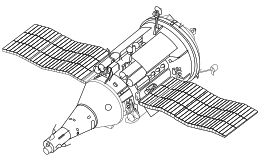
Back ТСК (космически кораб) Bulgarian TKS (kosmická loď) Czech TKS (Raumschiff) German TKS (kosmoŝipo) Esperanto TKS Spanish TKS (vaisseau spatial) French TKS (חללית) HE टीकेएस (अंतरिक्ष यान) Hindi TKSZ Hungarian TKS (wahana antariksa) ID
 | |
| Applications | Crewed spacecraft to supply the military Almaz space station |
|---|---|
| Specifications | |
| Crew capacity | 3 |
| Volume | 45.00 m3 (1,589 cu ft) |
| Regime | low Earth orbit |
| Design life | 7 days |
| Dimensions | |
| Length | 13.2 m (43 ft) |
| Diameter | 4.15 m (13.6 ft) |
| Maximum thrust | 7,840 N (1,760 lbf) |
| Propellant | N2O4/UDMH |
| Configuration | |
 Cutaway of TKS vehicle. Details are conjectural. The broad black line outlines the vehicle's pressurized compartments. A tunnel (stippled) connects the FGB and VA spacecraft | |
The TKS spacecraft (Russian: Транспортный корабль снабжения, Transportnyi Korabl’ Snabzheniia, Transport Supply Spacecraft,[1] GRAU index 11F72) was a Soviet spacecraft conceived in the late 1960s for resupply flights to the military Almaz space station.
The spacecraft was designed for both crewed and autonomous uncrewed cargo resupply flights, but was never used operationally in its intended role – only four test missions were flown (including three that docked to Salyut space stations) during the program. The Functional Cargo Block (FGB) of the TKS spacecraft later formed the basis of several space station modules, including the Zarya FGB module on the International Space Station.
The TKS spacecraft consisted of two spacecraft mated together, both of which could operate independently:
- The VA spacecraft (known mistakenly in the West as the Merkur spacecraft), which would have housed the cosmonauts during launch and reentry of a TKS spacecraft, while traveling to and from an Almaz space station.
- And the Functional Cargo Block (FGB) which, in order to resupply an Almaz space station, carried docking hardware, tanks, and a large pressurized cargo compartment. Furthermore, the FGB carried the on-orbit maneuvering engines for the TKS.
While the VA carried the reentry hardware, and only minimal life support and maneuvering systems, the FGB would have been used as the primary orbital maneuvering system and cargo storage for the TKS spacecraft.
The FGB could also be used alone as an uncrewed cargo module without a VA spacecraft, which enabled the FGB design to be re-purposed as FGB space station modules later on. The VA spacecraft, on the other hand, was also intended to be launched as "Almaz APOS", mated with an Almaz-OPS space station core as the primary orbital maneuvering system, instead of an FGB.
In the 2010s, Excalibur Almaz planned to use old VA capsules as low-cost cargo return vehicles.[2] However, the company ultimately sold much of their equipment and announced that the remainder was to become an educational exhibit.[3]
- ^ "Space Race – SPIES IN SPACE". Smithsonian – National Air and Space Museum. Archived from the original on 10 December 2012. Retrieved 1 September 2012.
- ^ "Beating swords into plowshares with Soviet Almaz". Spaceflight Now. 18 August 2009. Retrieved 30 March 2010.
- ^ "Shooting for the Moon: Time is called on Isle of Man space race". Independent.co.uk. 11 March 2015. Archived from the original on 26 May 2022.
© MMXXIII Rich X Search. We shall prevail. All rights reserved. Rich X Search